 W
WAcynodon is an extinct genus of alligatoroid crocodilian. When first described it was placed within the family Alligatoridae, but has since been reclassified as a globidontan. It is the oldest and most primitive globidontan known to date, with fossils being found from France, Spain, Italy, and Slovenia. Acynodon first appeared during the early Campanian stage of the Late Cretaceous and became extinct during the Cretaceous–Paleogene extinction event at the Cretaceous–Paleogene boundary. The skull of Acynodon is extremely brevirostrine; it had a very short and broad snout compared to other known alligatorids. Its dentition was quite derived, with enlarged molariform teeth and a lack of maxillary and dentary caniniform teeth, presumably an adaptation to feed on slow prey with hard shells. The paravertebral osteoderms of Acynodon were distinctively double-keeled.
 W
WAnachlysictis gracilis is an extinct carnivorous mammal belonging to the group Sparassodonta, which were metatherians that inhabited South America during the Cenozoic. Unlike other remains assigned to the family Thylacosmilidae that had been found previously, Anachlysictis is the first record of such borhyaenoids in northern South America, and also most primitive and ancient in the family. This species was found in the Villavieja Formation in the area of La Venta in Colombia, a famous fossil deposit in the Middle Miocene, based on fragments that include a front portion of the lower jaw, with an incipient molar tooth and a piece of carnassial from the front of the maxilla.
 W
WAphanizocnemus is an extinct genus of varanoid lizard from Lebanon. It is a marine lizard that lived during the Late Cretaceous. It is often classified in the family Dolichosauridae as a close relative of snakes, although some studies have placed it as an even closer relative to snakes than dolichosaurids. Only one species of Aphanizocnemus is known, the type species A. libanensis. A. libanensis was named in 1997 on the basis of a single complete skeleton. Although the type locality is unknown, it is said to "almost certainly" originate from the Sannine Formation.
 W
WArchaeoceratops, meaning "ancient horned face", is a genus of basal neoceratopsian dinosaur from the Early Cretaceous of north central China. It appears to have been bipedal and quite small with a comparatively large head. Unlike many later ceratopsians it had no horns, possessing only a small bony frill projecting from the back of its head.
 W
WArchaeomarasmius is an extinct genus of gilled fungus in the Agaricales family Tricholomataceae, containing the single species Archaeomarasmius leggetti. It is known from two fruit bodies recovered from amber, one consisting of a complete cap with a broken stem, the other consisting of a fragment of a cap. The cap has a diameter ranging from 3.2 to 6 mm, while the stem is 0.5 mm (0.02 in) thick. Spores were also recovered from the amber, and are broadly ellipsoid to egg-shaped, measuring roughly 7.3 by 4.7 μm. The species, which resembles the extant genera Marasmius and Marasmiellus, is inferred to have been saprobic on plant litter or other forest debris.
 W
WAsioryctitheria is an extinct order of early eutherians.
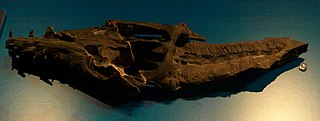 W
WAugustasaurus is a genus of aquatic sauropterygian reptile belonging to the Pistosauria, a clade containing plesiosaurs and their close relatives. Pistosaurus and Augustasaurus were thought to be the only known members of the family Pistosauridae. However, some recent cladistic analyses found Augustasaurus to be a more advanced pistosaur, as a sister group of the order Plesiosauria. The only known species of Augustasaurus is Augustasaurus hagdorni, which was first described in 1997.
 W
WAustralopithecus garhi is a species of australopithecine from the Bouri Formation in the Afar Region of Ethiopia 2.6–2.5 million years ago (mya) during the Early Pleistocene. The first remains were described in 1999 based on several skeletal elements uncovered in the three years preceding. A. garhi was originally considered to have been a direct ancestor to Homo and the human line, but is now thought to have been an offshoot. Like other australopithecines, A. garhi had a brain volume of 450 cc (27 cu in); a jaw which jutted out (prognathism); relatively large molars and premolars; adaptations for both walking on two legs (bipedalism) and grasping while climbing (arboreality); and it is possible that, though unclear if, males were larger than females. One individual, presumed female based on size, may have been 140 cm tall.
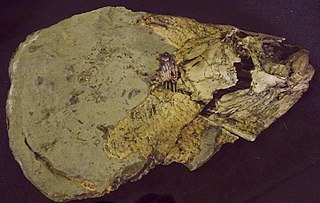 W
WBachea is an extinct genus of ray-finned fish that lived during the Late Cretaceous in what is now central Colombia, South America. The type species is B. huilensis, described in 1997 by María Páramo from the Turonian of Huila, Colombia.
 W
WBaikuris is an extinct genus of ant in the Formicidae subfamily Sphecomyrminae, and is currently placed in the tribe Sphecomyrmini. The genus contains four described species: the type species Baikuris mandibularis, along with Baikuris casei, Baikuris maximus, and Baikuris mirabilis.
 W
WBiseridens is an extinct genus of anomodont therapsid, and one of the most basal anomodont genera known. Originally known from a partial skull misidentified as an 'eotitanosuchian' in 1997, another well-preserved skull was found in the Xidagou Formation, an outcropping in the Qilian Mountains of Gansu, China, in 2009 that clarified its relationships to anomodonts, such as the dicynodonts.
 W
WBorealosuchus is an extinct genus of crocodylians that lived from the Late Cretaceous to the Eocene in North America. It was named by Chris Brochu in 1997 for several species that had been assigned to Leidyosuchus. The species assigned to it are: B. sternbergii, the type species, from the Maastrichtian of Colorado, Montana, North Dakota, South Dakota, and Wyoming; B. acutidentatus, from the Paleocene of Saskatchewan; B. formidabilis, from the Paleocene of North Dakota; B. griffithi, from the Paleocene of Alberta; and B. wilsoni, from the Eocene of Wyoming. B. formidabilis is particularly well-known, represented by the remains of many individuals from the Wannagan Creek site in North Dakota.
 W
WBrownimecia is an extinct genus of ants, the only genus in the tribe Brownimeciini and subfamily Brownimeciinae of the Formicidae. Fossils of the single identified species, Brownimecia clavata, are known from the Middle Cretaceous of North America. The genus is one of several ants described from Middle Cretaceous ambers of New Jersey. Brownimecia was initially placed in the subfamily Ponerinae, until it was transferred to its own subfamily in 2003; it can be distinguished from other ants due to its unusual sickle-like mandibles and other morphological features that makes this ant unique among the Formicidae. The ant is also small, measuring 3.43 millimetres (0.135 in), and a stinger is present in almost all of the specimens collected. The morphology of the mandibles suggest a high level of feeding specialization.
 W
WCaypullisaurus is an extinct genus of large platypterygiine ophthalmosaurid ichthyosaur from the Late Jurassic to the Early Cretaceous of Argentina. Its holotype was collected from the Vaca Muerta Formation of Cerro Lotena, Neuquen, dating to the early Tithonian stage of the Late Jurassic, about 150 million years ago. Caypullisaurus was first named by Marta Fernández in 1997 and the type species is Caypullisaurus bonapartei. It is a member of the family Ophthalmosauridae, and closely related to Platypterygius and Brachypterygius. In 2012, Caypullisaurus was found to be most closely related to Athabascasaurus and "Platypterygius" australis, and to nest within the subfamily Platypterygiinae.
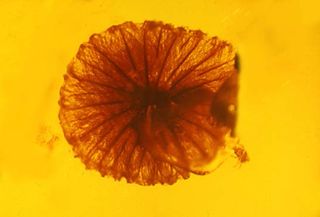 W
WCoprinites is an extinct monotypic genus of gilled fungus in the Agaricales family Agaricaceae. At present it contains the single species Coprinites dominicana.
 W
WDukecynus is an extinct genus of meat-eating metatherian belonging to the order Sparassodonta, which lived in South America during the Middle Miocene (Laventan), between about 13.8 and 11.8 million years ago. The name of the genus meaning "Duke dog", for Duke University and the Greek word cynos, dog, for the pretended similarity of this animal with dogs. A single species known so far, Dukecynus magnus. The species name "magnus" derives from Latin for big, to reflect their great size.
 W
WEmeroleter is an extinct genus of nycteroleterid parareptile known from the early Late Permian of European Russia. It was a long-legged lizard-like small animal with a length about 30 cm.
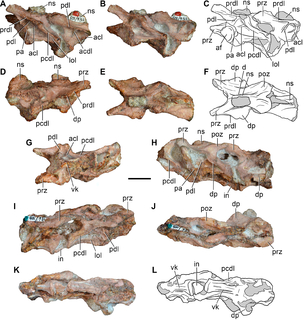 W
WEorasaurus is an extinct genus of archosauromorph reptile known from the middle Late Permian of Tatarstan, European Russia. It contains a single species, Eorasaurus olsoni. When originally described by Sennikov (1997), Eorasaurus was identified as an early archosauromorph and assigned to the family Protorosauridae, Ezcurra et al. (2014) and Ezcurra (2016) later reclassified Eorasaurus and placed it within the group Archosauriformes. Eorasaurus is based solely on scant fossil material from the neck region, and is thus considered an unstable taxon in phylogenetic analyses. If Eorasaurus is an archosauriform, it would be the oldest known member of the group and would pre-date the previous record holder.
 W
WEosipterus is an extinct genus of ctenochasmatid pterosaur from the Early Cretaceous period of Liaoning, China. Fossil remains of Eosipterus dated back to the Aptian stage of the Early Cretaceous, 124.6 million years ago.
 W
WGranastrapotherium is an extinct genus of ungulate mammals, described from remains found in rocks of the Honda Group in the Tatacoa Desert, in the Colombian departments of Huila and Tolima, at the Miocene fossil site La Venta. The only species formally recognized is Granastrapotherium snorki. Remains found in Bolivia and Peru, seem to belong to Granastrapotherium or a very similar animal.
 W
WHomo antecessor is an archaic human species of the Lower Paleolithic, known to have been present in Western Europe between about 1.2 million and 0.8 million years ago (Mya). It was described in 1997 by Eudald Carbonell, Juan Luis Arsuaga and José María Bermúdez de Castro, who based on its "unique mix of modern and primitive traits" classified it as a previously unknown archaic human species.
 W
WJesairosaurus is an extinct genus of early archosauromorph reptile known from the Illizi Province of Algeria. It is known from a single species, Jesairosaurus lehmani. Although a potential relative of the long-necked tanystropheids, this lightly-built reptile could instead be characterized by its relatively short neck as well as various skull features.
 W
WKoolasuchus is an extinct genus of brachyopoid temnospondyl in the family Chigutisauridae. Fossils have been found from Victoria, Australia and date back 120 Ma to the Aptian stage of the Early Cretaceous. Koolasuchus is the youngest known temnospondyl. Koolasuchus is known from several fragments of the skull and other bones such as vertebrae, ribs, and pectoral elements. The type species Koolasuchus cleelandi was named in 1997.
 W
WKupferzellia is an extinct genus of Triassic capitosauroid temnospondyl amphibian.
 W
WLibonectes is an extinct genus of sauropterygian reptile belonging to the plesiosaur order. It is known from specimens found in the Britton Formation of Texas (USA) and the Akrabou Formation of Morocco, which have been dated to the lower Turonian stage of the late Cretaceous period.
 W
WLongchengornis is a genus of enantiornithean birds which lived during the early Cretaceous Period, about 120 mya, and is known from a fossil found in the Jiufotang Formation in Liaoning province, People's Republic of China. It contains the single species L. sanyanensis, though some researchers believe this to be a synonym of the similar species Cathayornis yandica.
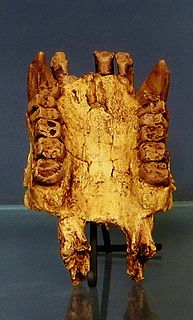 W
WMorotopithecus is a species of fossil ape discovered in Miocene-age deposits of Moroto, Uganda.
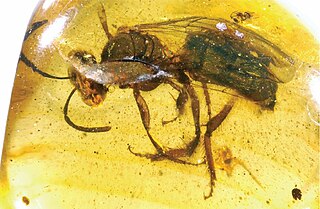 W
WOligochlora is an extinct genus of sweat bee in the Halictidae subfamily Halictinae. The genus currently contains six species, all of which are known from the early Miocene Burdigalian stage Dominican amber deposits on the island of Hispaniola.
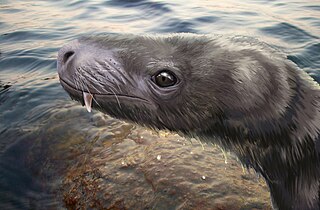 W
WPerplexisaurus is a genus of therocephalian therapsid from the Middle to Late Permian Deltavjatia vjatkensis Assemblage Zone, Vanyushonki Member of the Urpalov Formation of Russia. It was described by L. P. Tatarinov in 1997, and the type species is P. foveatus. A new species, P. lepusculus, was described by M.F. Ivachnenko in 2011, from Russia.
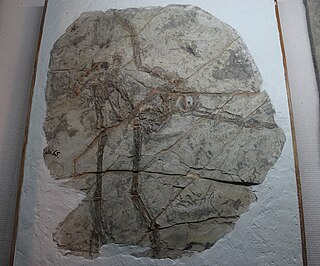 W
WProtarchaeopteryx is a genus of turkey-sized feathered theropod dinosaur from China. Known from the Jianshangou bed of the Yixian Formation, it lived during the early Aptian age of the Early Cretaceous, approximately 124.6 million years ago. It was probably an herbivore or omnivore, although its hands were very similar to those of small carnivorous dinosaurs. It appears to be one of the most basal members of the Oviraptorosauria, closely related to Incisivosaurus, or a taxon slightly less closely related to birds than oviraptorosaurs were.
 W
WProtomycena is an extinct monotypic genus of gilled fungus in the family Mycenaceae, of order Agaricales. At present it contains the single species Protomycena electra, known from a single specimen collected in an amber mine in the Cordillera Septentrional area of the Dominican Republic. The fruit body of the fungus has a convex cap that is 5 mm (0.2 in) in diameter, with distantly spaced gills on the underside. The curved stipe is smooth and cylindrical, measuring 0.75 mm (0.030 in) thick by 10 mm (0.39 in) long, and lacks a ring. It resembles extant species of the genus Mycena. Protomycena is one of only five known agaric fungus species known in the fossil record and the second to be described from Dominican amber.
 W
WRhynchopsitta phillipsi is an extinct species of thick-billed parrot. It was described in 1997 from Late Pleistocene cave deposits from Nuevo León in northeastern Mexico. The specific epithet honours American ornithologist Allan Robert Phillips.
 W
WThe Riversleigh rainforest koala is an extinct marsupial, closely related to the extant koala, that inhabited northwestern Queensland in the early-middle Miocene. Along with species of sister genus Litokoala, the Riversleigh rainforest koala is the smallest representative of family Phascolarctide. Based on cladistic analysis, Nimiokoala is one of the more basal genera of Phascolarctide. It died out due to climate change rendering the environment more arid. It probably had a more generalized diet than that of the modern species, but its exact food preferences are unknown.
 W
WSamburupithecus is an extinct primate that lived in Kenya during the middle to late Miocene. The one species in this genus, Samburupithecus kiptalami, is known only from a maxilla fragment dated to 9.5 million years ago discovered in 1982 and formally described by Ishida & Pickford 1997. The type specimen KNM-SH 8531 was discovered by the Joint Japan-Kenya Expedition at the SH22 fossil site in the Samburu District, a locality where several other researchers found no ape fossils.
 W
WSillosuchus is a genus of shuvosaurid poposaurid archosaur that lived in South America during the Late Triassic period. Shuvosaurids were an unusual family of reptiles belonging to the group Poposauroidea; although their closest modern relatives are crocodilians, they were bipedal and lightly armored, with dinosaur-like hip and skull structures. Based on skull remains from members of the family such as Effigia, they were also toothless and likely beaked herbivores.
 W
WSwartpuntia is a monospecific genus of erniettomorph from the terminal Ediacaran period, with at least three quilted, leaf-shaped petaloids — probably five or six. The petaloids comprise vertical sheets of tubes filled with sand. Swartpuntia specimens range in length from 12 to 19 cm, and in width from 11.5 to 140 cm. The margin is serrated, with a 1 mm wide groove. A 14 mm wide stem extends down the middle, tapering towards the top, and stopping 25 mm from the tip. The stem has a V shaped ornamentation on it. The original fossils were found at, and named after, the Swartpunt farm between Aus and Rosh Pinah in Namibia. The generic name comes from Swartpunt, meaning black point in reference to the colour of the rocks. The specific name germsi honours Gerard Germs, who studied the Nama formation of geological beds.
 W
WUnenlagia is a genus of dromaeosaurid theropod dinosaur that lived in South America during the Late Cretaceous period. The genus Unenlagia has been assigned two species: U. comahuensis, the type species described by Novas and Puerta in 1997, and U. paynemili, described by Calvo et al. in 2004.
 W
WZhangheotherium is a genus of symmetrodont, an extinct order of mammals. Previously known from only the tall pointed crowned teeth, Zhangheotherium, described from Liaoning Province, China, fossils in 1997, is the first symmetrodont known from a complete skeleton. It was dated to between 145–125 million years ago in the Cretaceous. A single species, Zhangheotherium quinquecuspidens, is known.